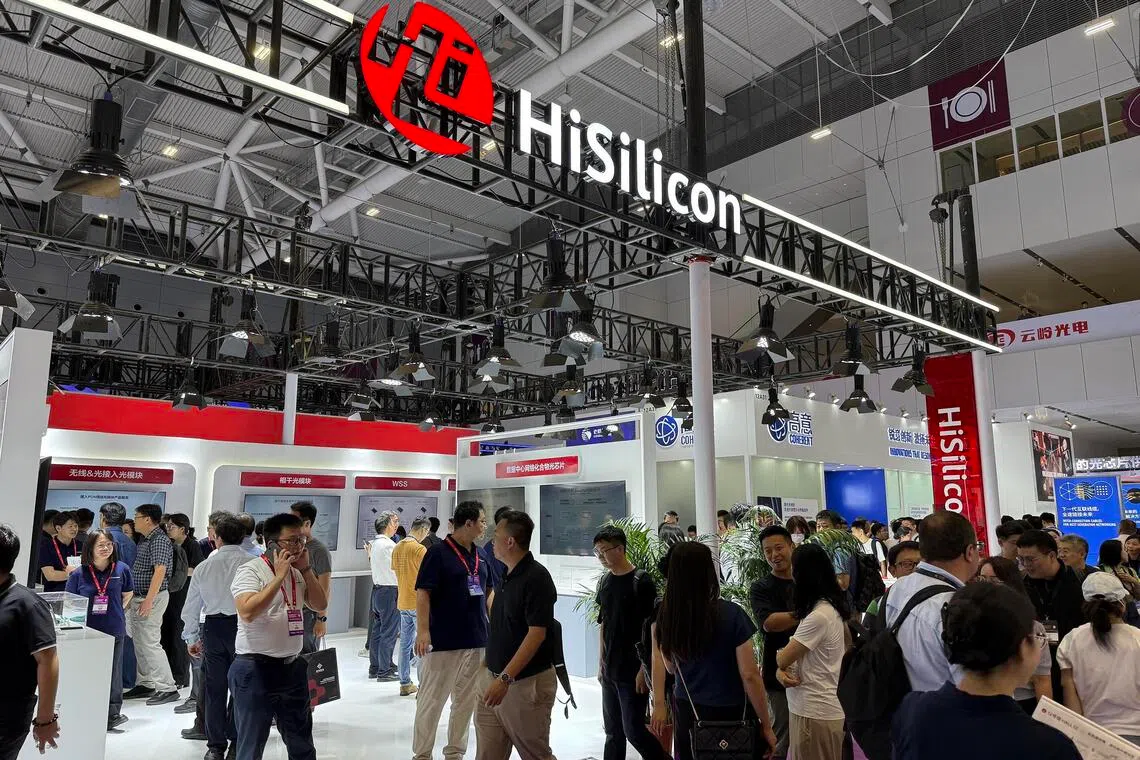China wants its companies to use local AI chips. Tech firms signal that they hear the call
Sign up now: Get insights on Asia's fast-moving developments

HiSilicon, the chip arm of Huawei, is among the bevy of chip design companies in China which are gunning to emulate Nvidia’s success with AI processors.
ST PHOTO: JOYCE ZK LIM
Follow topic:
- Chinese tech firms are showcasing support for domestic AI chips, driven by Beijing's push for self-sufficiency.
- While adoption grows, Chinese chips lag Nvidia in performance and ecosystem, hindering wider use beyond state-backed entities.
- Nvidia faces pressure in China, with restrictions and anti-monopoly scrutiny, as local firms like Huawei and start-ups aim to compete.
AI generated
SHENZHEN – Chinese tech companies have been showcasing support for home-grown artificial intelligence (AI) chips, as Beijing presses firms to curb their reliance on US chipmaker Nvidia and use local processors in a push for self-sufficiency.
Tencent Cloud said on Sept 16 that its computing platform, which uses many different chips to provide AI computing power, is fully adapted to support “mainstream domestic chips”.
“We are seeing more and more domestically produced chips being available in the market, I would say, in the past 12 months,” Tencent senior executive vice-president Dowson Tong told reporters on Sept 15. “We are using more, definitely.”
The company is not alone. Alibaba and Baidu are said to have begun using chips developed in-house to train some AI models, according to a report by tech publication The Information in September.
In August, Chinese AI start-up DeepSeek released an upgrade to its flagship large language model, saying it has a format compatible with the next generation of domestic chips. And in July, another Chinese model maker, StepFun, announced an “ecosystem innovation alliance” with a handful of local chip companies.
“The AI industry in China is changing rapidly, with greater uptake of domestic hardware, as we enter a transition period to what will likely be a fully Chinese AI stack,” said technology expert Paul Triolo, a partner at consultancy DGA-Albright Stonebridge Group.
“But we are not there yet,” he told The Straits Times, as firms continue to use a mix of local and Western solutions. “This process will take some time, but appears likely to be accelerated by domestic innovations, Chinese government preferences and continued export control pressure from the US.”
Adoption picks up, but it’s early days yet
Chinese tech firms’ adoption of domestic chips is “accelerating but remains partial”, noted Mr Charlie Dai, a vice-president and principal analyst at advisory firm Forrester Research.
By guiding firms towards domestic alternatives, China aims to “accelerate the maturation of its semiconductor ecosystem”, he added.
Locally developed AI chips are projected to take a 55 per cent share of the Chinese market in 2027, up from 17 per cent in 2023, according to a forecast by equity research and brokerage firm Bernstein.
“Currently, most (Chinese tech firms) are at the testing phase” when it comes to the adoption of home-grown chips, Dr Lin Qingyuan, a Bernstein senior analyst for China semiconductors, told ST.
Companies have looked to domestic processors because uncertainty around the supply of Nvidia’s H20 chips “forced local cloud service providers to find alternatives”, he said. Meanwhile, “local chip performance is catching up to match (the) H20”.
Still, wider adoption is hampered by the fact that Chinese chips – while improving – lag Nvidia’s offerings for now, analysts say.
The Financial Times reported in August that the release of DeepSeek’s new R2 model had been delayed after the company failed to train it on Huawei’s chips. Alibaba and Baidu still use Nvidia’s chips to develop their most advanced AI models, according to The Information.
It’s not just the chips’ raw performance. Nvidia’s edge owes much to its software ecosystem used to harness the chips, with its Cuda platform widely used by AI developers.
China also trails behind the cutting edge in high-bandwidth memory technology, which allows large AI workloads to run more efficiently. Additionally, the volume of advanced chips that Chinese foundries can churn out is currently limited, though this is said to ramp up in 2026.
Semiconductor analyst Ray Wang thinks it is still too early to conclude that Chinese tech firms’ adoption of home-grown processors has meaningfully increased. “For now, usage of domestic chips remains largely confined to state-backed agencies and government-linked data centres,” he said.
“If Nvidia solutions remain available in some form, I still expect them to dominate adoption, given their superior performance and ecosystem advantages, despite improvements in domestic offerings,” added the research director for semiconductors, supply chain and emerging tech at advisory firm The Futurum Group.

China is pressing firms to curb their reliance on US firm Nvidia and use local processors in a push for self-sufficiency.
ST PHOTO: JOYCE ZK LIM
Diverting demand from Nvidia?
In recent months, Nvidia has come under growing pressure from Beijing. On Sept 15, officials said the firm had violated China’s anti-monopoly law
The Chinese authorities have reportedly also told major tech firms to halt purchases
“China’s willingness to cut off Nvidia is a strong sign of its faith in its domestic capabilities,” wrote Dr Andrew Ng, a British-American AI expert who has worked at both Baidu and Google, in a LinkedIn post.
A bevy of chip design companies in China – ranging from tech giants to start-ups – are gunning to emulate Nvidia’s success with AI processors.
HiSilicon, the chip arm of Huawei, is seen as a leader on this front. It develops the Ascend range of AI chips, which are individually less powerful than Nvidia’s but can be clustered together to boost performance. The company unveiled on Sept 18 a three-year road map for new releases of these chips, and said it would double computing power with each annual release.
Tech giants like Alibaba and Baidu also design their own chips, via their T-Head and Kunlunxin units respectively. Both firms recently made headlines for having struck sizeable chip deals linked to state-owned telcos China Unicom and China Mobile respectively.
But Alibaba also announced on Sept 24 that it is partnering Nvidia on “physical AI” – or systems that include robots and autonomous cars – by integrating the US giant’s software stack with its cloud platform.
Then there are chip design start-ups in China like Cambricon and Hygon, which have seen their share prices surge on expectations that they would profit off demand diverted from Nvidia. Cambricon, which in the first half of 2025 saw its revenue soar 44-fold, briefly surged past Kweichow Moutai to become China’s most expensive stock in late August.
Still others like Chinese chip firms Moore Threads, MetaX and Enflame are moving to go public to raise funds for research and development. Many have founders who previously worked at US chip companies. Moore Threads, started by a former Nvidia executive, received regulatory approval on Sept 26 for a Shanghai listing.

Moore Threads’ booth at Tencent’s Global Digital Ecosystem Summit in September.
ST PHOTO: JOYCE ZK LIM
And many more are eyeing the AI chip scene.
“Nvidia is our goal,” says Mr Knight Jiang, a product director at a Xi’an-based graphics processing unit maker. His firm’s chips are not developed for AI workloads just yet, but it intends to wade into the booming field in the future.
“Right now we’re too far behind, and others may not think much of us,” he told ST. “But we have a goal, and we can set our sights on chasing it.”


